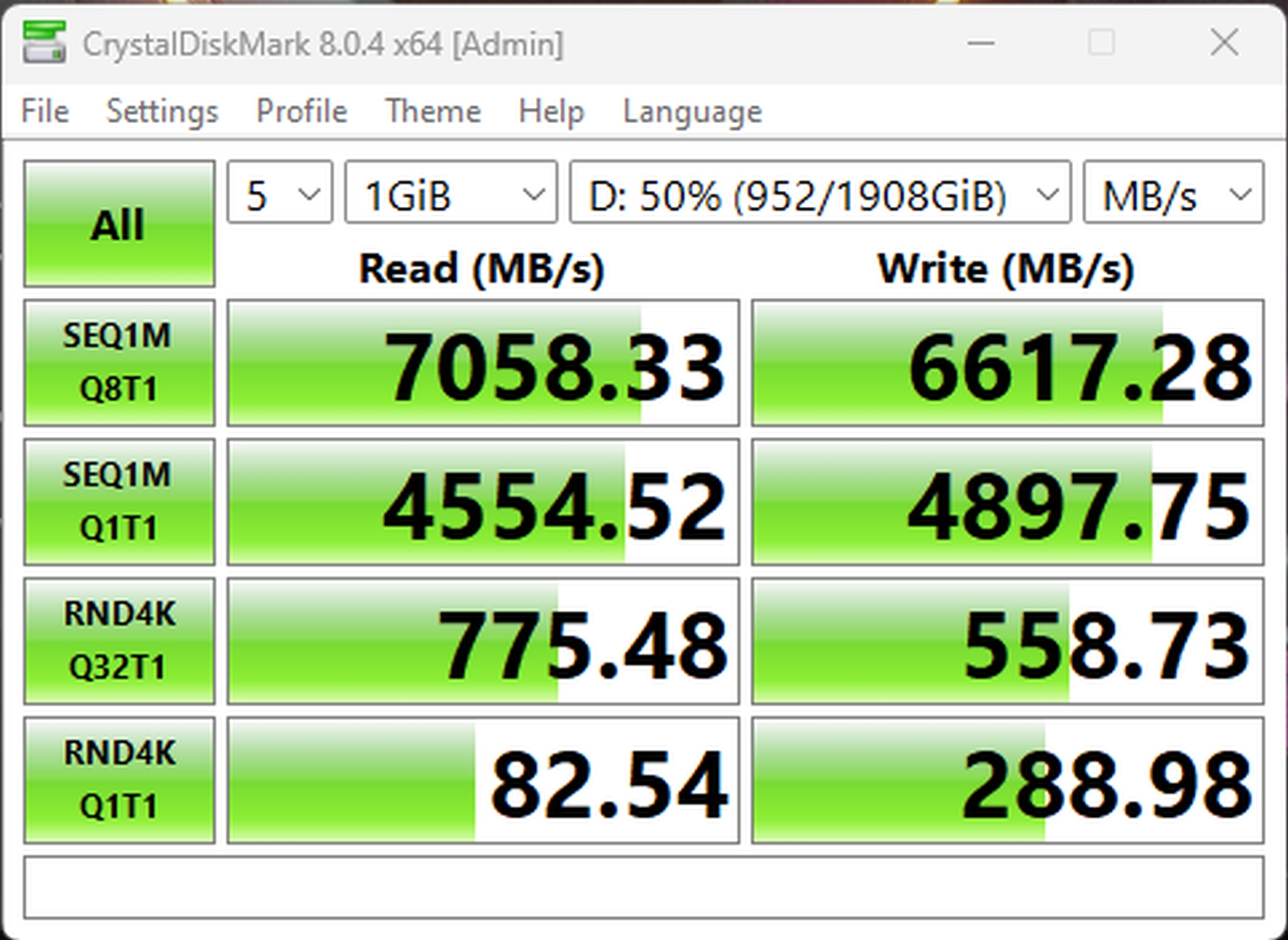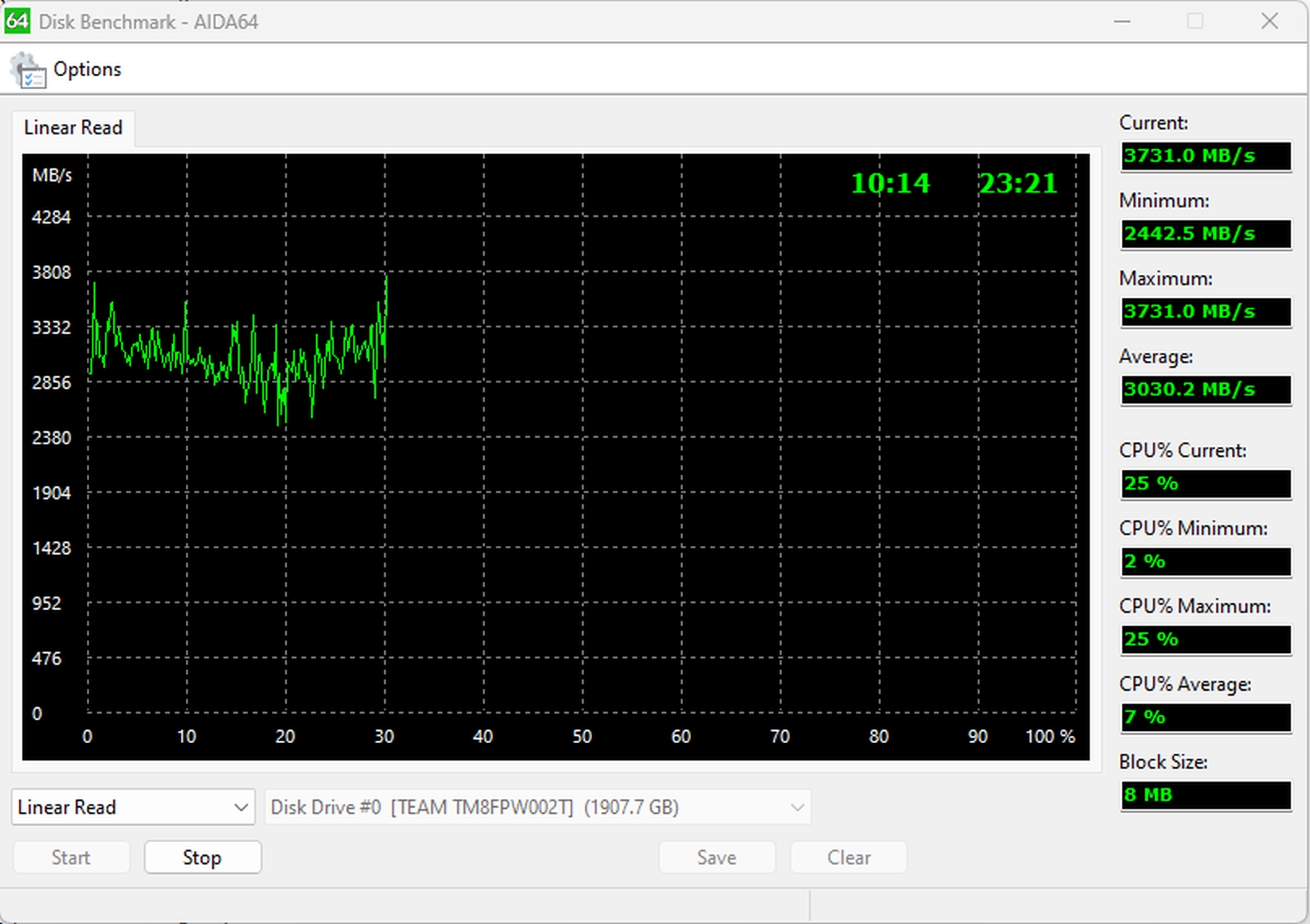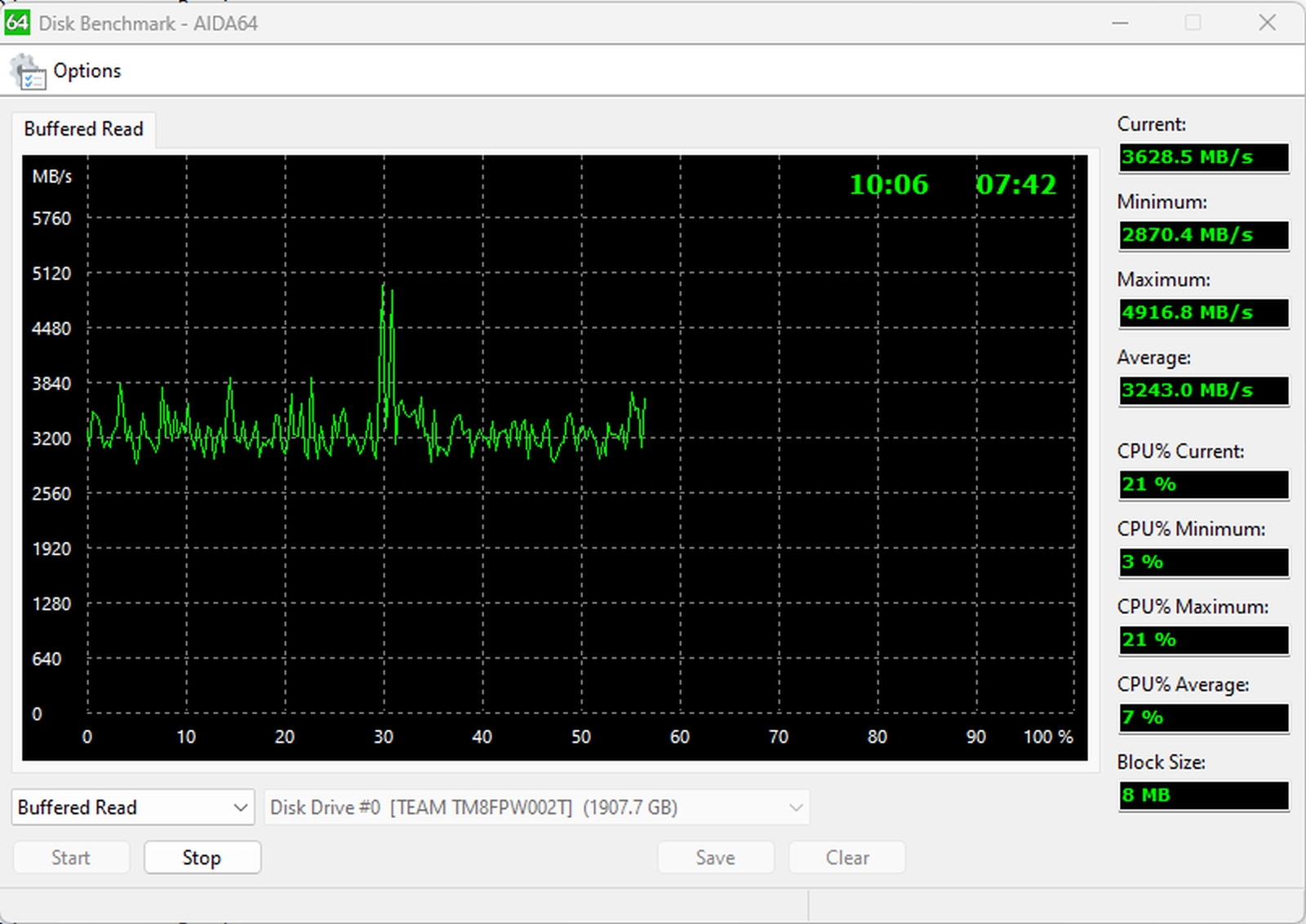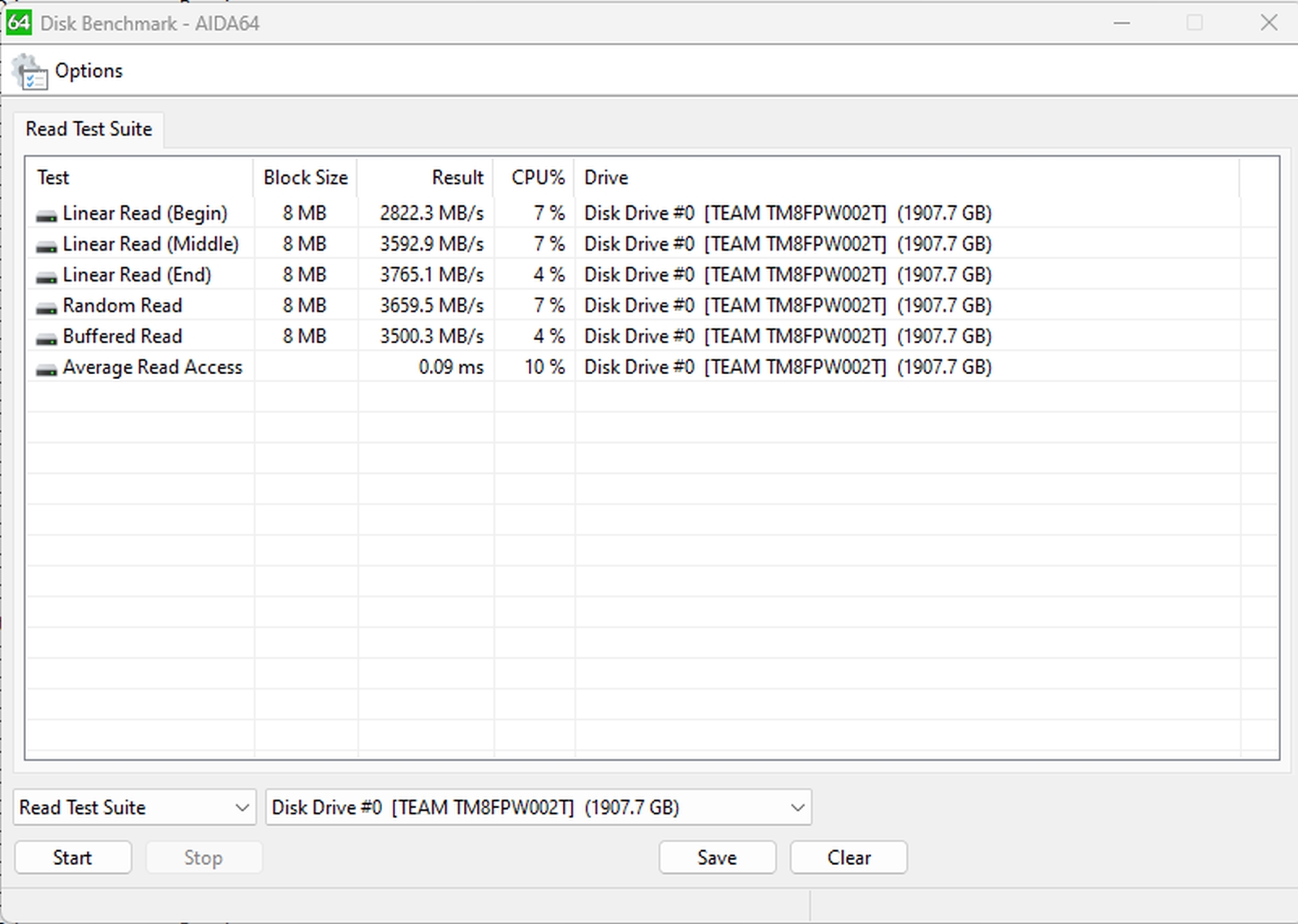
Teamgroup has been knocking it out of the park with their storage and RAM solutions lately, and recently we got our hands on their latest drive, the MP44. This M.2 PCIe 4.0 NVMe is big, fast, and somehow still reasonably priced. There’s gotta be a catch, right? We picked up the 2TB model, threw every test we had at it, and decided for ourselves.
If you’ve not heard of Teamgroup, that’s not uncommon – they aren’t one of the bigger names you see spending millions of dollars on a constant barrage of advertising. That said, I’m sure they drive those big names insane as they continue to deliver a tremendous amount of value at a price the big boys simply can’t match. Our review of the Cardea T-Force A440 Pro certainly showed that, as that drive was able to push past some of the best drives on the market, and at a price point that was easily 25% less than their competitors. Teamgroup has been working as a manufacturer since 1997, achieving full vertical integration. This means they are responsible for their own product design, materials, manufacturing, and quality control. They partner with the best in the business for controllers, just like everyone else, but they are able to ensure that the products they release are of the highest quality. Let’s get under the hood and see why.

The Teamgroup M44 M.2 NVMe is a PCIe Gen 4×4 NVMe drive, with a stated theoretical maximum of 7,400 MB/s read speeds, and 6,900 MB/s write speed. It is built with a 232-layer TLC NAND, offering capacities of 1TB, 2TB, 4TB, and even 8TB – we’re looking at the 2TB for our review. The controller moves to one we’ve not seen – the Maxio MAP1602A. All of this sounds great, but then I had a moment of pause – there’s no DRAM cache.
Testing DRAM-less drives in the past, there are a number of behaviors to be aware of that might impact your use case. Drives without RAM often struggle when they approach max capacity, seeing a massive drop-off in speed and performance, and in some cases, even reliability. RAM on a drive contains a map of sorts, telling the drive precisely where things are stored. Drives with DRAM store that map in memory, whereas DRAM-less SSDs store it in slower flash cells. This constant access on the flash memory can shorten the lifespan of the drive, which is why you often see a shorter warranty, or a far lower recommended TBW, or Terabytes Written. We’ll return to this subject when we look at overall performance and warranty on the MP44, but for now, let’s put a pin in this.
THe MP44 is a 2280 form factor, meaning it’s 22mm wide and 80mm long, filling an M.2 slot on your motherboard. It’s also the right size for your PlayStation 5 (and given the install size on games like Final Fantasy VII Rebirth, you’ll want that 4TB model!). While it doesn’t carry a certification for the PS5, I’ve been running it for nearly two months without a single hitch. It’ll also fit in many NUCs, NAS, or laptops, though you’ll want to check your manufacturer to make sure the form factor is correct. The point being, it can add “versatile” to its list of attributes. Now let’s look at performance, starting with the PlayStation 5.
The PlayStation 5 has a certification process for their “approved” list, but any PCIe 4.0 4×4 model that can reach speeds in excess of 5,500 MB/s of read throughput will suffice. It’ll also support drives up to 8TB in size. The MP44 can hit speeds in excess of 7000 MB/s, but there’s a hitch – you won’t see that number when you test the drive in your PlayStation 5. Why? Well, that has more to do with the theoretical maximums of Sony’s hardware than the drive. I’ve tested quite a few drives in the PlayStation, and the numbers range wildly from around 5,600 MB/s to 6,500 MB/s. Can you reasonably tell the difference between those two numbers? No, but why the variance? In a word – heat.
The MP44 does not come with a heat sink, so if you intend to use this drive inside your PlayStation 5, you’ll want to pick one up, though you won’t need a thermal pad – more on that in a second. With a heat sink on, you’ll be leaving the metal door off the side, but rest assured that it’s not going anywhere. This drive, and all NVMe drives, perform best when they are kept cool. In practice, higher quality drives we’ve tested that were able to keep cool saw speeds near the 6,500 MB/s mark consistently. Ones that ran hotter fell down to around 5,500 MB/s. It’s not just speed either – higher heat can cause thermal throttling to get the heat under control, though we’ve not seen that with this drive quite yet. It can also drastically reduce the lifespan of the drive. Instead, on Sony’s platform we are simply seeing the maximum speeds of the hardware. As such, any drive that can achieve the required speeds will be fine, including this one, as long as you can keep it below the recommended temperature thresholds.
I do want to backtrack and touch on something I’d missed on this drive and others the first time around. These are labeled “Graphene” and it never occurred to me that it was anything more than a marketing buzzword. In reality, this label is a patented thermal pad that keeps the drive cooler, even without a heatsink. If you are using an older board, or one without a heat sink cover, you’ll still achieve some level of heat dissipation beyond simple passive cooling with nearby fans. It’s a nice addition and one I’d not recognized until now.
Back on PC, I’m testing this on an MSI Z790 Motherboard with an Intel 13900K processor and DDR5 running at 7600 MT/s – no bottlenecks on the test rig. We run our synthetic tests using a number of utilities including 3DMark, AIDA 64 Professional, ATTO, and Crystal Diskmark. While these will show the theoretical maximums, which is important to see the highs and lows the drive can achieve, they also give a comprehensive overview of performance over time. They also show what happens when you hit DRAM exhaustion, as well as some real-world examples of what you might see in practice. Let’s start off with Crystal Diskmark.
The advertised maximum rates on these drives are around 7400 / 6900, and we see a read/write speed fairly near those numbers with the drive at 30% full. Pumping it up to that 90% mark that should cause this drive to fall off a cliff in terms of performance, but somehow…it doesn’t. Remarkably, there’s almost no difference between empty, partial, half, or even almost full in terms of read and write speeds. That new Maxio controller is utilizing the RAM in my PC for that data map, and it’s doing so at a level of efficiency that I simply didn’t expect. Normally my recommendation is to overbuy so you have more “usable” space at full speed, but that might not be necessary any longer. Let’s fire up CrystalDiskMark and check those theoretical maximums:

While CrystalDiskmark gives us a look at snapshot, it’s designed more to showcase the drive running flat out. To see those results across a sustained read and write, and with a variety of block sizes, we’d need ATTO.

I like it when I can see consistent results out of a drive. Once the block size hits 256 KB, we see the MP44 settle into a nice comfortable spot, pushing roughly 6.5 GB/s read and 6.05 GB/s write speeds, where it rests comfortably throughout the remainder of the test. Without DRAM I would have expected to see a dropoff.
Another important aspect of drive work is the access time. Speeds are important, but fast access times are almost more important. Moving over to AIDA64’s Engineering suite we can test that and more.

This has to be the most boring graph, but that’s exactly what you need here. The MP44 sits at 0.09 ms average, with a low of 0.08 ms and a max of 0.09 ms for access speeds across the entire test. Drives where you can see a pause before things begin to load are drives that would have a more thready graph here – a sure sign of a cheap drive. Here we see the MP44 being remarkably consistent.
Read speeds are likely your most valuable test for gaming as you’ll spend far more reading from the drive than writing to it. As such, we look at the random read, linear, buffered, and average read. We also like the summation screen as it puts it all together with some real-world testing. Let’s look at them in order.

Before you get excited about these numbers, realize that these are what you’d get if you threw out that location map we discussed when we talked about DRAM. This is the drive just picking a random spot, reading it, and then picking another random spot. Like driving without a map, it’s hardly representative of reality, nor a great way to get from A to B. More likely, it’ll be something like this:

Most of the time, items on a drive are clustered together in a sector or at least nearby – they aren’t scattered randomly. Here we see real-world speeds that are more in line with a freshly-written file stack. This is where optimization can come in.

What you see is a solid improvement, thanks to buffering. Some pre-cached files are pulled forward, ready to be accessed, resulting in a speed boost. The aggregation of all of these together looks like this:

Running the AIDA64 comprehensive test we see aggregate numbers around what we found in other tests, for similar block sizes. This graph just summarizes the others in one spot, though the 8 MB block size should be larger to properly test the drive. Let’s check out 3DMark.
3DMark has a benchmark that pushes the drive with real world games. Overwatch, Call of Duty, The Outer Worlds, and other real-game examples are loaded up multiple times to test initial load times, streaming, file transfers, saves, and more. Just like our other tests, it’s an amalgamation of file sizes, showcasing how the drive might perform in production. While the number it produces is only truly comparable against itself, it does give you another real-world data point.
Synthetic tests are one thing, but real world applications and performance is far more important. We use a mixture of Dragon’s Dogma 2, Enshrouded, Helldivers 2, Baldur’s Gate 3, and Star Citizen, with the latter being far from scientific as it’s still Alpha — it’s just for fun. Across the board in our synthetic tests we see load times consistent with the top tier drives on the market, even ones that come in at a 25% premium over the Teamgroup drive. In real-world tests we see similar results – access, read, and write, and load speeds that are imperceptible from the WD_Black SN850X, Crucial P3, and Crucial T500. It’s only when we make the jump to PCIe 5.0 that we finally see the P44 eclipsed, though that’s a generational gap, so it’s expected.
The last thing we look at in our hardware reviews is price and warranty. The MP44 is priced at just $75 – a full $25 less than its nearest competitor. Moving to 2TB the price pops to $123 – a marginal increase to reach the drive we’re talking about today. The 4TB on the other hand is the price to performance sweet spot at $223. The 8TB on the other hand is priced at a premium, leaping up to $859. Though we haven’t had a chance to test the two higher capacity drives, the pricing that Teamgroup has chosen is certainly pushing to capture the market at the 4TB and smaller capacities. The fact that they’ve done this while cutting DRAM, but somehow not affecting the performance, places the MP44 in a fantastic position amid their competitors.
DRAM-less drives are typically priced to move, but their performance suffers at DRAM exhaustion. The new controller chip in the MP44 dodges this problem, but that means you’ll take a hit on overall lifespan as the flash chips are being accessed more often, right? Glad to say that this isn’t the case. The MP44’s ratings are 1,450TBW for the 1TB, 2,500TBW for the 2TB, 3,000TBW for the 4TB, and 6,000TBW for the 8TB – well in excess of DRAM-equipped drives from other manufacturers. They’ve also coupled it with a five year warranty.
When I reviewed the Cardea A440 I decided to log some basic support tickets to test out the support from the manufacturers. I prompted their agents with some basic support questions about installation, compatibility, and their RMA processes. If needed, you’ll have to mail the drive back to their California office. Unfortunately that will be at your own expense, though the return is free. Most companies do cross-ship RMA for free, so perhaps that’s something Teamgroup can improve. Still – the five year warranty is on par with the top tier of the industry, so that’s encouraging that they stand behind their product. Not too shabby from a company you might not have heard of before today, eh?
Teamgroup MP44 PCIe 4.0 NVMe
Excellent
The MP44 is another fantastic entry from the storage division of Teamgroup. It offers a massive amount of space, great heat dissipation, and remarkably consistent read and write speeds.
Pros
- Solid price to performance
- New controller solves DRAM-less issue
- Included graphene thermal pad is appreciated
- PlayStation 5 compatible
- 5 year warranty
Cons
- You are on the hook for RMA shipping
